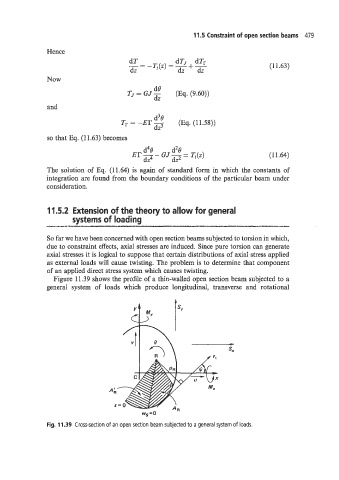Page 498 - Aircraft Stuctures for Engineering Student
P. 498
11.5 Constraint of open section beams 479
Hence
dT - T,(Z) = -+- (1 1.63)
dTJ dTr
dz dz &-
Now
dB
TJ = GJ- (Eq. (9.60))
dz
and
d30
Tr = -Er - (Eq. (1 1.58))
dz3
so that Eq. (1 1.63) becomes
d46' d2B
Er - GJ - - T~(~) (11.64)
-
d# &2 -
The solution of Eq. (11.64) is again of standard form in which the constants of
integration are found from the boundary conditions of the particular beam under
consideration.
11.5.2 Extension of the theory to allow for general
systems of loading
-".-.-- Il_i-_l---:
So far we have been concerned with open section beams subjected to torsion in which,
due to constraint effects, axial stresses are induced. Since pure torsion can generate
axial stresses it is logical to suppose that certain distributions of axial stress applied
as external loads will cause twisting. The problem is to determine that component
of an applied direct stress system which causes twisting.
Figure 11.39 shows the profile of a thin-walled open section beam subjected to a
general system of loads which produce longitudinal, transverse and -rotational
A
SY
Fig. 11.39 Cross-section of an open section beam subjected to a general system of loads.

